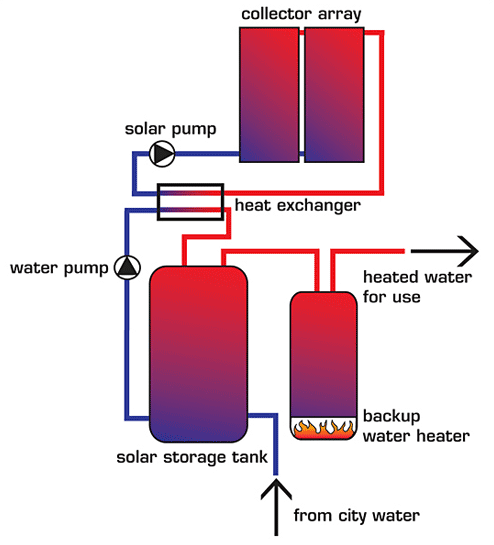Technologies for Energy Efficiency
Ease of installation
Early collector technology of the 1970's included the manufacture of the panels and parts as separate entities. An early solar pioneer writes in 1977, in the Whole Earth Catalog: "Our solar heater was a square box affair and it had four tanks in it and it was covered by glass. It faced southwest, of course, just the direction the house was. It was our main supply of hot water. The pipes came down through the house from the heater, one went to the bathroom, and one went to the kitchen. There was no excess of plumbing."6 Today, solar hot water heating systems can be installed by most plumbers. These solar panels are specified in one pre-packaged "plug and play" unit. The collectors, heat exchangers, controllers, and storage tanks are provided with standard NPT plumbing fittings to make connections to home plumbing systems an easy fit. The installation of a typical hot water system takes approximately two days.
Day 1 - the installer checks the orientation of the roof for placement. The ideal orientation is to have the panel face true south or be within 15 degrees. The roof slope should range between 20 and 45 degrees, however, some panels can be installed in slopes from 10 or15 degrees. In snowy areas, the recommended roof slope is at least 30 degrees and a 10 degree slope is a minimum for rain to wash leaves and dust from the collector surface. The solar aspect is also reviewed to see how many hours of the day the roof receives direct sunlight without being shaded by adjacent trees or buildings.
A solar collector is sized not by the square footage of the home, but by the number of people living in the home. Installers estimate that a typical homeowner will use up to 20 gallons of hot water per day; for a family of four the storage tank will be sized for 80 gallons.
Collector placement is determined by solar aspect as well as relationship to existing or new plumbing fixtures. A solar storage tank will be placed next to an existing hot water tank in the garage, basement or in a centralized location in the home from which hot water is distributed. The shortest piping run is the least expensive and plumbing lines can be up to 100 feet without resizing pipe diameters.
Day 2 - a solar hot water package system is delivered to the site and the collector raised to the roof where it is mounted and piping drilled through the roof. Many cities require licensed roofers to mount solar collectors. Good mounting hardware, flashing, and sealing all roof penetrations will assure leak-proof construction. The installer works from the collector down into the tank with piping and final power connections for the heat exchanger.
The installer returns after a day to assure that there are no leaks. A commercial installation can be much larger and needs to be designed by a Mechanical Engineer. Installation may take longer, however, the sequence of construction is very similar to that in a residential application. ASHRAE provides solar heating systems guidelines for commercial solar water heating systems that can be found at the Solar Rating and Certification SRCC Standard website.
Case Study: Fenway Park |
||||||||||||
Multiple heat exchangers are used to transfer the heat from the solar collectors to the water storage tanks. Photo courtesy of Heliodyne Twenty-eight solar collectors line a roof at Fenway Park, providing hot water for the vendors selling food to the Boston Red Sox fans. The Sox are the first team in Major League Baseball to have a solar water heating system at their ballpark. This system is expected to reduce the park's water-heating energy demand by an average of 30 percent annually. Approximately 36,000 lbs. of CO2 are expected to be offset every year from the newly installed solar system - the equivalent of planting five acres of trees every year. Along with the twenty-eight collectors, the system includes flush mount kits, thirty-two gallons of solar fluid (for a closed loop cold climate installation), four heat-transfer appliances or heat exchangers and four 400-gallon solar storage tanks. Originally designed to heat the water for both the restaurants and the bathrooms, this system is a good example of corporate responsibility. "The Red Sox have a duty and responsibility to help protect and preserve the environment and to help keep the Fenway neighborhood clean and green," said Red Sox President/CEO Larry Lucchino. "The installation of solar thermal panels is the next step in our commitment to endeavor to make ‘America's Most Beloved Ballpark' one of America's greenest ballparks."7
(25-year period with est. 10 percent annual utility rate increase.) |
||||||||||||
Â
 |
Diagram of a typical residential solar hot water system Diagram courtesy of Heliodyne |










